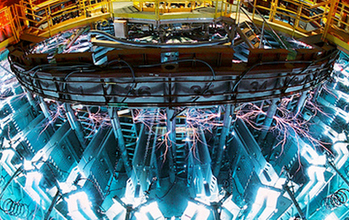News Release 16-106
U.S. sees sizable increase in R&D spending
Totals rose by $20 billion in 2014; similar increase estimated for 2015

The business sector was the largest funder of R&D. The federal government was the second-largest.
September 15, 2016
This material is available primarily for archival purposes. Telephone numbers or other contact information may be out of date; please see current contact information at media contacts.
U.S. research and development (R&D) performance rose to $477.7 billion in 2014 -- an increase of $21.1 billion over the previous year -- and is estimated to hit $499.3 billion in 2015, according to a new report from the National Center for Science and Engineering Statistics (NCSES).
The NCSES report looks at two different aspects of the U.S. system: the performance of R&D by businesses, government agencies, higher education institutions and other organizations, and the funding sources used by these sectors to perform that R&D.
R&D performance
Adjusted for inflation, growth in U.S. total R&D performance averaged 1.2 percent annually between 2008 and 2014, matching the average pace of U.S. gross domestic product (GDP). The NCSES data show increases of $20.4 billion in 2013, $21.1 billion in 2014 and an estimated $21.6 billion in 2015.
U.S. R&D performance breaks down into three categories: basic research ($84 billion of the 2014 total), applied research ($93.6 billion) and experimental development ($300.1 billion). Federal funding accounted for 45 percent of basic research, 36 percent of applied research and 16 percent of development. Business funding accounted for 27 percent of basic research, 52 percent of applied research and 82 percent of development.
The business sector is by far the largest performer of U.S. R&D, accounting for $340.7 billion, or 71 percent of the total in 2014. The sector has long been the predominant performer, with an annual share ranging between 68 percent and 74 percent over the past 20 years.
The higher education sector is the second-largest performer of R&D, with universities and colleges performing $64.7 billion, or 14 percent of the total in 2014. From 2012 to 2014, higher education annual increases dropped below $1 billion.
The federal government conducted $52.3 billion, or 11 percent, of U.S. R&D in 2014, of which $34.4 billion was performed by agencies in their own facilities, with the remainder performed at federally funded research and development centers (FFRDCs).
R&D funding
The business sector was the largest funder of R&D, accounting for $318.6 billion of the 2014 total of $477.7 billion. Nearly all of the business sector's funding -- 98 percent -- was directed at R&D performance by businesses.
The federal government was the second largest funder, at $119.8 billion. The federal government directed $34.4 billion of its funding to R&D at agencies, $17.5 to FFRDCs, $26.6 billion to businesses and $34.1 billion to academic institutions.
-NSF-
Media Contacts
Rob Margetta, NSF, (703) 292-2663, email: rmargett@nsf.gov
Program Contacts
Mark Boroush, NSF, (703) 292-8726, email: mboroush@nsf.gov
The U.S. National Science Foundation propels the nation forward by advancing fundamental research in all fields of science and engineering. NSF supports research and people by providing facilities, instruments and funding to support their ingenuity and sustain the U.S. as a global leader in research and innovation. With a fiscal year 2023 budget of $9.5 billion, NSF funds reach all 50 states through grants to nearly 2,000 colleges, universities and institutions. Each year, NSF receives more than 40,000 competitive proposals and makes about 11,000 new awards. Those awards include support for cooperative research with industry, Arctic and Antarctic research and operations, and U.S. participation in international scientific efforts.
Connect with us online
NSF website: nsf.gov
NSF News: nsf.gov/news
For News Media: nsf.gov/news/newsroom
Statistics: nsf.gov/statistics/
Awards database: nsf.gov/awardsearch/
Follow us on social
Twitter: twitter.com/NSF
Facebook: facebook.com/US.NSF
Instagram: instagram.com/nsfgov


